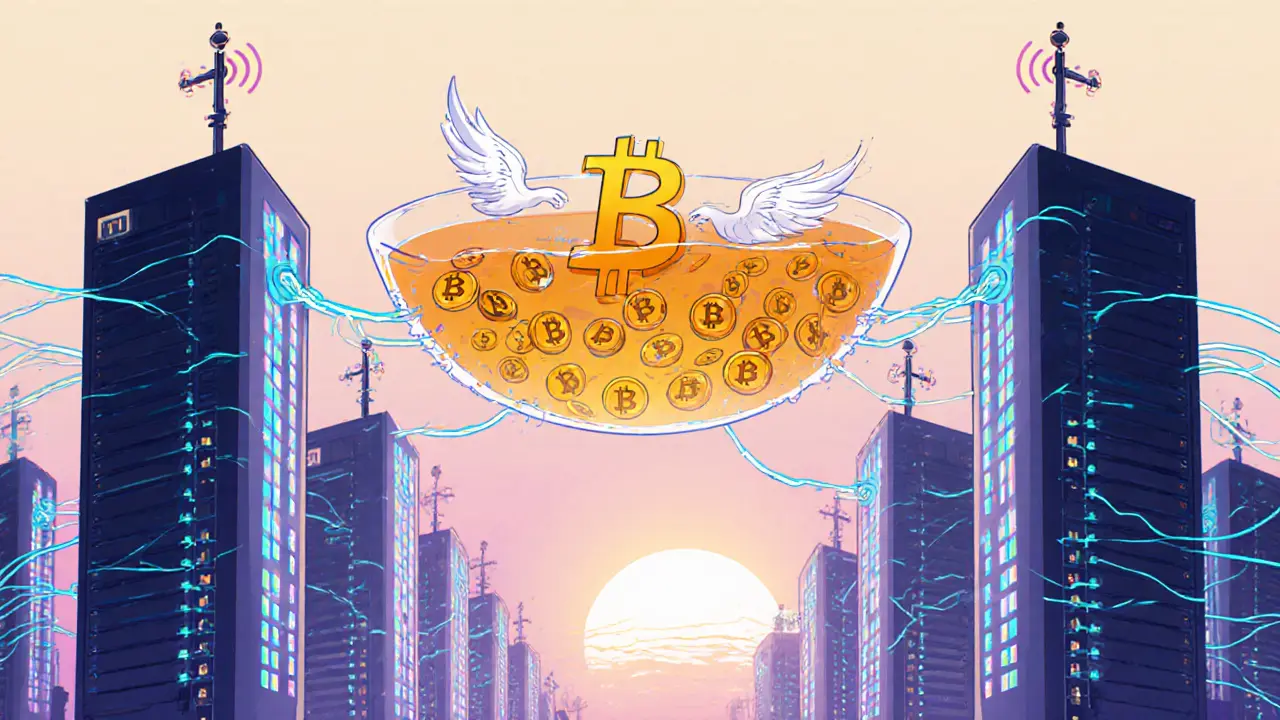
Bitcoin Mempool Fee Estimator
Estimated Fee Information
Enter transaction details and click "Estimate Transaction Fee" to see fee estimates.
Mempool Insight
Bitcoin transactions are prioritized by fee rate (satoshis/vByte). Higher fees usually mean faster confirmation. Current mempool conditions affect fee rates.
Note: This estimator uses standard fee ranges based on typical mempool behavior. Actual fees may vary.
When you send Bitcoin, the transaction doesn’t jump straight into a block. It first lands in a holding area that most people never see - the Bitcoin mempool is a distributed temporary storage pool where unconfirmed transactions wait for miners to pick them up. Because every full node runs its own copy, the mempool isn’t a single queue but a network‑wide chorus of caches that together keep the system fluid.
Key Takeaways
- The mempool lives on every full Bitcoin node, not on a central server.
- Default settings keep the pool around 300MB and purge transactions after two weeks.
- Miners prioritize transactions by fee rate, creating a real‑time fee market.
- Monitoring tools let users gauge congestion and choose the right fee.
- Understanding the mempool helps avoid overpaying or getting stuck during spikes.
What Exactly Is the Mempool?
In plain terms, the mempool is a Bitcoin node software that validates and relays transactions, keeping a local list of those that haven’t been confirmed yet. When a wallet broadcasts a transaction, each node that receives it runs the full set of consensus rules - checks for sufficient balance, double‑spends, correct signatures, and so on. If the transaction passes, the node adds it to its own mempool.
Because nodes can be configured differently, their mempools may diverge slightly. Most nodes stick to Bitcoin Core’s defaults, which means the global view is fairly uniform, but power users can raise the maxmempool the maximum size a node will allow for its mempool, default 300MB or shorten the mempoolexpiry the time after which stale transactions are dropped, default 336hours.
The Five‑Step Journey of a Transaction
- Broadcast: Your wallet sends the transaction to a handful of peers.
- Validation: Each receiving node applies consensus rules and, if everything checks out, stores the transaction in its mempool.
- Propagation: Validated transactions are relayed further, spreading across the network’s many mempools.
- Selection: miners operators who build new blocks, typically choosing the highest‑fee‑per‑virtual‑byte transactions first scan the mempool and construct a candidate block.
- Confirmation: Once a miner finds a valid proof‑of‑work, the block is broadcast, the included transactions become confirmed, and all nodes promptly remove them from their mempools.
This workflow ensures that only transactions meeting the network’s rules ever reach a block, while the fee market decides who gets in faster.
Default Settings You Should Know
Bitcoin Core’s out‑of‑the‑box configuration looks like this:
| Parameter | Default Value | What It Controls |
|---|---|---|
| maxmempool | 300MB | Maximum total size of the mempool |
| mempoolexpiry | 336hours (2weeks) | How long a transaction can sit idle before being dropped |
| minrelaytxfee | 0.00001BTC/kvB (1sat/vByte) | Minimum fee rate a node will forward to peers |
Changing any of these values is a trade‑off between resource usage and visibility. Larger pools capture more low‑fee traffic but demand more RAM and disk I/O.

How the Fee Market Shapes Priority
Because each block only holds about 1MB of data, miners compete for space. They rank transactions by fee rate the amount paid per virtual byte, often expressed in satoshis/vByte. A high fee rate pushes a transaction toward the top of the mempool queue, while a low rate may sit for hours or days during congestion.
Tools like mempool explorers expose the current fee distribution. For example, during a typical day you might see these rough targets:
- 10sat/vB - confirmation within 6hours (if the network is calm).
- 30sat/vB - confirmation in the next block (≈10minutes).
- 50+sat/vB - priority for urgent transfers.
These numbers shift dramatically when the market spikes - think of a sudden price rally or a popular NFT mint. That’s why watching the mempool before you send matters.
Monitoring the Mempool: Tools & Best Practices
Even if you don’t run a full node, you can tap into public APIs or web‑based mempool explorers services that visualize current mempool size, fee rates, and transaction counts. Popular options include mempool.space, Johoe’s Bitcoin Mempool Statistics, and Blockstream’s Explorer.
When you’re planning a transaction:
- Check the current median fee rate for the desired confirmation window.
- Set your wallet’s custom fee accordingly (most wallets let you override the “recommended” fee).
- If you’re not in a hurry, consider a “replace‑by‑fee” (RBF) enabled transaction so you can bump the fee later if the mempool stays busy.
Running your own node gives you the getrawmempool an RPC call that returns a list of transaction IDs currently held in the node’s mempool. You can pair that with getmempoolentry to fetch per‑transaction fee rates, size, and age, enabling fully automated fee‑optimization scripts.
Common Pitfalls and How to Fix Them
Transactions stuck for days. Typically this means you set a fee below the current market minimum. Use an RBF transaction to replace it with a higher fee, or use a “child‑pay‑for‑parent” (CPFP) strategy by sending a new transaction that spends the stuck one with a hefty fee.
Node mempool out of sync. If you run a personal node with custom maxmempool settings, you might drop low‑fee transactions early, causing peers to see a different view. Align your settings with the default or monitor your mempoolinfo RPC output to understand what’s being discarded.
Fee estimation errors. Wallets rely on recent block data. During rapid spikes, the estimate may lag. Refresh the fee chart right before sending, or manually input a higher fee based on explorer data.
Future Directions: Why the Mempool Still Matters
Even as the Lightning Network starts handling many micro‑payments off‑chain, the on‑chain mempool remains the settlement backbone. Newer Bitcoin Core releases aim to improve fee estimation algorithms making them more responsive to sudden demand spikes and to better synchronize mempool policies across nodes.
Developers are also experimenting with “priority fees” that let users flag transactions for faster relay without paying the full miner fee. While still experimental, such ideas highlight the mempool’s central role in Bitcoin’s evolving economics.
Frequently Asked Questions
What does “mempool congestion” mean?
Congestion occurs when the number of pending transactions exceeds the space miners can fit in a block. The mempool grows, fee rates rise, and low‑fee transactions wait longer.
Can I clear my own mempool?
Yes. If you run a full node, you can restart it with a different maxmempool value or use the clearmempool RPC command (available in newer Core versions) to drop all unconfirmed transactions locally.
What’s the difference between a mempool and a transaction pool?
In Bitcoin the terms are interchangeable; both refer to the list of unconfirmed transactions held by a node.
How do I know if my transaction has been dropped?
Check a block explorer for your transaction ID. If it’s missing after the mempoolexpiry period (default 336hours), the node has removed it. You’ll need to rebroadcast with a higher fee.
Do all nodes share the exact same mempool?
No. Each node keeps its own copy based on the transactions it receives and its configuration. However, most follow Bitcoin Core defaults, so the overall view is very similar across the network.


Comments
Natasha Nelson
So the mempool is basically like a waiting room where transactions sit until they pay enough to get in? I always thought it was some magic blockchain thing... turns out it's just a queue with a price tag. 😅
Prabhleen Bhatti
Wow, this is such a crisp breakdown! In India, we often see mempool congestion during crypto rallies-people sending BTC for remittances without realizing fees spike. I've seen transactions stuck for 72+ hours because they used the wallet's default. Always check mempool.space now-game changer. 🙌
Richard Williams
Love this. Seriously, if you're new to Bitcoin and think sending BTC is like sending an email-this is your wake-up call. The mempool is the heartbeat of the network's fee market. You don't just send-you negotiate. And knowing how to read it? That's power.
Elizabeth Mitchell
Interesting. I never paid attention to this before. I just hit send and hope for the best. Guess I’ve been lucky so far.
Chris Houser
Big up to the author for breaking this down without jargon overload. In Nigeria, where many rely on crypto for daily transactions, understanding mempool dynamics isn’t optional-it’s survival. I teach my students to always use RBF. It’s saved more than one payment.
William Burns
It's amusing how casually people treat the mempool as if it's a utility service. This isn't Amazon Prime-there's no guaranteed delivery. The fact that you need to monitor fee rates like a stock trader reveals the inherent inefficiency of Bitcoin's design. Perhaps we should reconsider decentralization's trade-offs.
Ashley Cecil
While the technical exposition is largely accurate, the omission of any mention of the UTXO model's role in mempool validation is a glaring conceptual gap. Transactions are not merely ‘checked’-they are verified against a globally consistent state tree. This is not a queue; it is a state-dependent validation pipeline. Please correct this in future iterations.
Joseph Eckelkamp
Oh, so the mempool is just a fee auction where the rich get priority and the rest of us wait? How revolutionary. 🤡 I mean, I knew Bitcoin wasn’t a bank, but I didn’t realize it was basically Wall Street with a blockchain overlay. At least we get to watch the drama unfold in real time-like a crypto version of ‘The Hunger Games’ but with satoshis instead of arrows.
Jennifer Rosada
It's irresponsible to suggest that users should ‘just use RBF’ without emphasizing that many wallets still don't enable it by default-and worse, some exchanges disable it entirely. This isn’t just a technical oversight; it’s a systemic failure to protect ordinary users from fee traps. You’re not helping-you’re enabling.
adam pop
Wait... so the mempool is controlled by miners? Who controls the miners? Who controls the miners' software? Who controls the people who write the software? This isn’t decentralization-it’s a rigged system where a handful of pools dictate who gets to transact. They’re using the mempool to enforce control. The Fed is just using Bitcoin now. 😈
Dimitri Breiner
One thing people forget: the mempool isn’t just about fees-it’s about timing. If you’re sending a payment for a physical good that needs confirmation within 15 minutes, you need to know what the mempool looks like at that exact hour. I use a script that checks every 2 minutes and auto-adjusts. Works like a charm.
LeAnn Dolly-Powell
Thank you for explaining this so clearly! 🥹 I used to panic every time my transaction took forever-now I just open mempool.space and breathe. It’s like checking the weather before leaving the house. Also, I love that you mentioned CPFP-my friend just used it to rescue a stuck payment and now she’s obsessed with Bitcoin. 🙏💖
Sarah Hannay
While I appreciate the technical clarity of this post, I must respectfully note that the casual tone risks trivializing the economic gravity of the mempool. The fee market is not a game-it is a mechanism that determines access to a global, permissionless financial system. For millions without traditional banking, this is not a convenience-it is a lifeline. Please consider the human stakes when framing technical discourse.
John E Owren
Just wanted to add: if you're running a node and your mempool keeps getting pruned too early, check your maxmempool setting. I bumped mine to 500MB and suddenly started seeing low-fee transactions that others were missing. It helped me catch a few good arbitrage opportunities too. Not that I trade-but hey, knowledge is power.